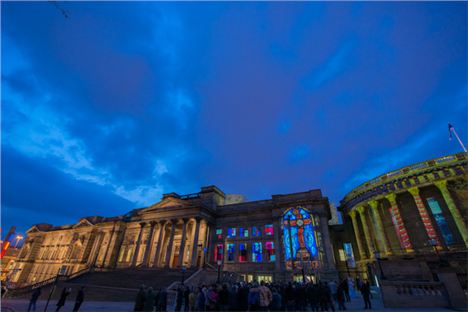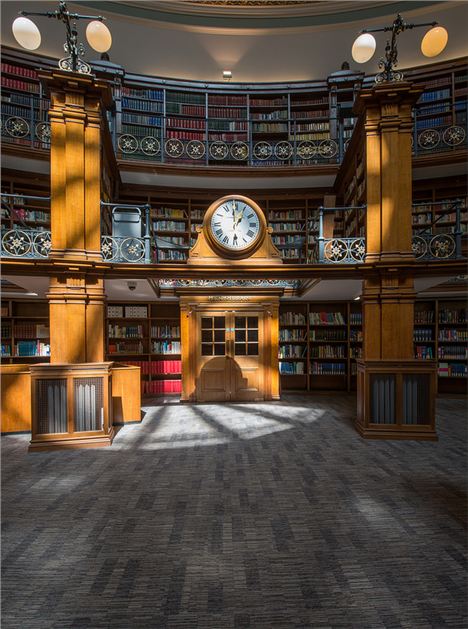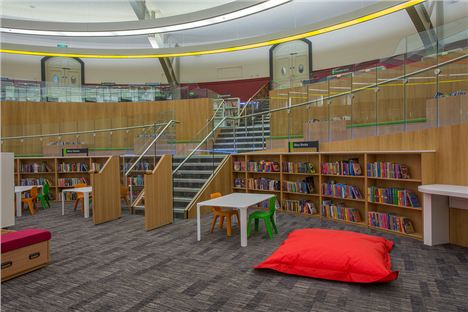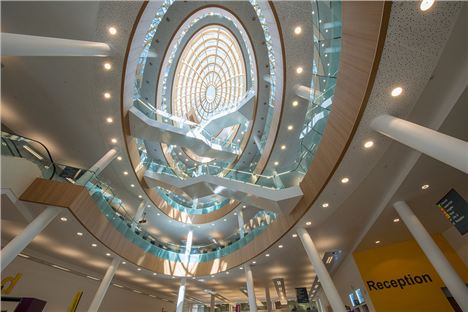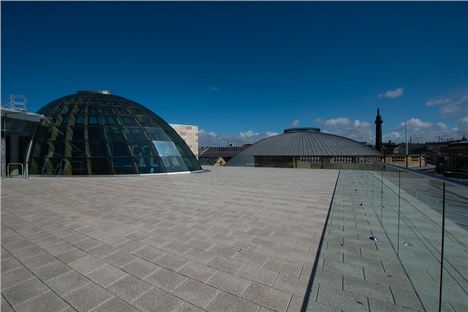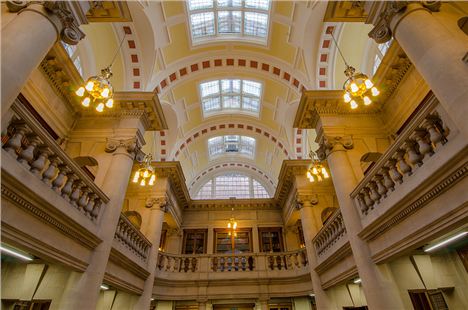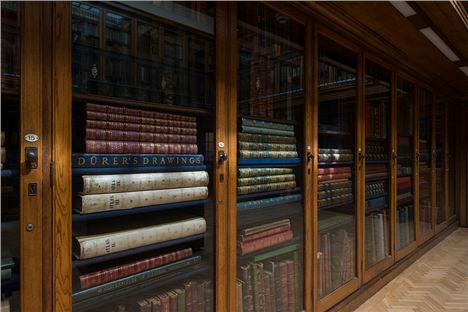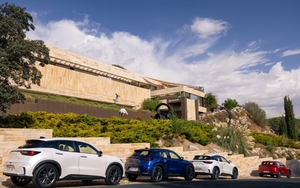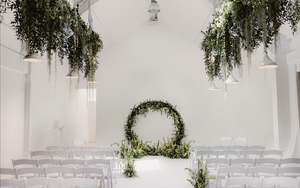THE events calendar in Liverpool seems to be getting into a higher gear, what with Writing on the Wall and the upcoming Light Night celebrations arriving on the back of Sound City.
But certain events have special significance in the cultural life of the city. Special in that they take years of careful detailed planning, will have a lasting impact on generations to come and truly bring it right into the 21st century.
I'm talking about the newly-refurbished Central Library on William Brown Street - itself part of the grand high-cultural quarter on the World Heritage site including the World Museum Liverpool, the Walker Art Gallery and St Georges Hall. These have all undergone major improvements over the last 20 years or so. The Central Library was, in effect, the last piece of this master plan and now it's completed, the city can be justifiably proud of the result.
Some years ago, I went on a fact-finding visit to Glasgow to learn more about how they dealt with bringing their Mitchell Library up-to-date. Similar scenario - important landmark in the City Centre, underused and well past its prime.
The big questions were, simply, how to make it accessible and attractive, how to achieve sympathetic restoration whilst introducing new digital technologies and, finally, how to cater for a wide variety of public needs and expectations.
The experience was very useful as it helped to identify best practice prior to creating the vision which Joyce Little [Head of Libraries and Information Services] and her dedicated team had to make reality. To say that this has been simply "achieved" is a huge understatement. It's gone way past that.
Firstly, a brief history of the building itself. Opened originally in 1860, it was a fitting monument by the Victorian great and good to promote civic virtue and self-improvement.
The building was hit by a bomb during World War II which practically destroyed the interior and many thousands of books and archives were lost, yet the facade remained intact.
The remodelled interiors built during the 1950s and 1970s were piecemeal and had to be done quickly and cheaply. These were, essentially, utility improvements rather than a wholesale refit.
Over the years, the International Library had to close and the Hornby Library and Oak Room were mothballed. Attempts were made to bring it up-to-date with a new business information facility [LADSIRLAC], childrens library and LP collection but, overall, it just wasn't fit for purpose. It was time for the vision to become reality.
This was created through a PFI-funded scheme backed by the City Council and Inspire Partnership. Other key agencies were Austin-Smith Lloyd, Buro Happold and RoC Consulting.
The overall scheme involved the architecturally-sensitive interior demolition of the old Brown Library and eight-storey extension between the Walker and World Museum [everything taken out the back]. Next came the complete refit of the interior including a five-storey library and atrium, new entrance and conservation studio. And much more. Oh, yes, much, much more.
Let's start from when you actually arrive.
The "wow" factor kicks in immediately. A new inscribed granite carpet [or Literary Pavement] has been laid out with a whole host of international book and film titles within it. It's an impressive welcome.
 Don't ask To the side is an automated book/DVD return facility which gives you a receipt. That’ll prove popular. Upon entering the building, what strikes is the light openness and stunning 21st century architecture. Basically, a new interior has been constructed within the shell of the existing facade and this enables more natural light to enter. It is simply breathtaking. Each floor hangs in space supported by ingenious columns with staircases spanning in-between. You'd probably get the same sensation if you'd entered the Tardis.
Don't ask To the side is an automated book/DVD return facility which gives you a receipt. That’ll prove popular. Upon entering the building, what strikes is the light openness and stunning 21st century architecture. Basically, a new interior has been constructed within the shell of the existing facade and this enables more natural light to enter. It is simply breathtaking. Each floor hangs in space supported by ingenious columns with staircases spanning in-between. You'd probably get the same sensation if you'd entered the Tardis.
Separate bright and cheerful areas have been created...Discover, Read, Imagine, Enquire, Game.
It's about as far removed from dusty Dewey-Decimal as you can get. There's a comfortable modern cafe area to the left, an abundance of computer terminals and everywhere is carpeted. Several customer terminals are dotted around where people can check-out their own books or learning/entertainment materials.
Along one wall near the entrance is a panel denoting Liverpool Firsts, dating back to the Royal Charter of 1207.
Together with the internal modernisation of the interior, the other major task was the restoration of the Picton Reading Room, Hornby Library and the Oak Room.
Expert conservationists were brought in to restore the ironwork and gilded features, including the time-honoured clock. The soft echo is still there though. All the woodwork has been french-polished with authentic paintwork matching the original Victorian treatment. Another major feature was the transformation of the International Library [now Discover] which is now a dedicated childrens library and theatre space. No “shushing” allowed there, obviously. Kids and parents will love it.
The Oak Room is, now, home to the special display of an Audubon “Birds of America” volume. Incredibly rare and valuable, it’s one of the Crown jewels of the Library’s collection. Each page will be turned once a week in a highly-delicate operation.
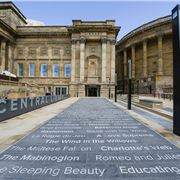
On the other floors are the Record Archive and Repository containing some 17kms of material [the largest archive outside London], a high-tech conservation studio, community meeting rooms and roof terrace with a spectacular view across the back of St Georges Hall and St Johns Gardens.
To the rear of the library is a wall panel with the names of 53 writers who have a strong connection with Liverpool. You actually get a better view of this as you drive down the Churchill Way flyover.
Going back to the new interior, you feel like you’re in a space station as you traverse between the floors on the suspended staircases. These floors contain over 355,000 books, music, DVDs and magazines. No shortage of choice, then, including an abundance of computer terminals.
So, overall, what to make of this newly-minted asset in the City’s cultural and educational portfolio?
If first impressions count, then it certainly worked for me. I expect that the projected million visitors in its opening year will easily be matched since it has the advantage of an ideal location with the added bonus of “must-visit” attraction.
 Joyce LittleAs Joyce Little says “People will see it as a very different library experience…which is exactly what we wanted”.
Joyce LittleAs Joyce Little says “People will see it as a very different library experience…which is exactly what we wanted”.
In fact, the very word “Library” itself doesn’t do it justice. Knowledge bank, genealogy store, research facility, discovery centre, idea factory, inspiration place would all be more fitting. Go see for yourself…there’s a whole new world right on your doorstep.








